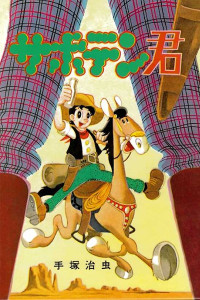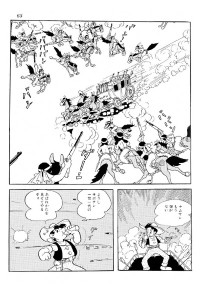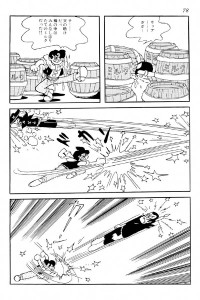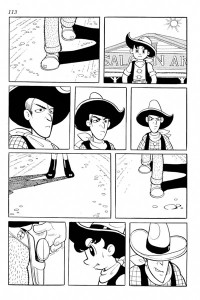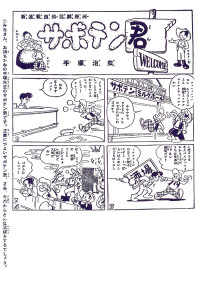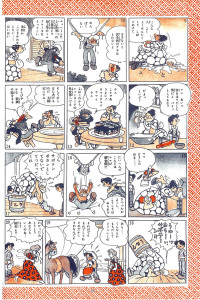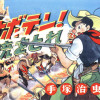Cactus Kid, The (Manga)
Also known as サボテン君 (Saboten Kun)
| English Title: | The Cactus Kid |
| In English? | Yes |
| Japanese Title: | サボテン君 Saboten Kun |
| Type: | Chapter Serial |
| Original run: Second run: |
1951/04 – 1953/03 1953/12 – 1954/12 |
| Published in: | Shonen Illustrated 少年画報 |
| Published by: | Shonen Gahosha |
| Volumes: | 1 MT-069 |
Also sometimes referred to as Milkhall Territory, Osamu Tezuka’s cowboy adventure, The Cactus Kid (1951-54) was originally published over 23 monthly instalments in Shonen Illustrated from April 1951 to March 1953. It was followed by Cyrano the Hero (1953) from April to November 1953, before resuming for another 12 monthly instalments from December 1953 to December 1954. One stand-alone story, known as Cactus, Get your Gun!, was also published as a supplement to the September 1952 edition of Shonen Illustrated.
What it’s about
“Cactus” Sam is just your regular, ordinary cowboy, but give him a glass of milk and he transforms from a calm, congenial, fellow into the rootin-est, tootin-est, six-gun shootin-est cowpoke you ever did see… and it just so happens his parents own the local “milk hall”.
Although not broken down into chapters per se, the story is comprised of several, loosely-connected, arcs – often centring around Cactus and his girlfriend, Alice, whose father is a local rancher and a member of the state assembly.
In these adventures, Cactus takes care of some bandits trying to rob the stagecoach; gets mixed up in a bad case of “gold fever”; helps a good man atone for the sins of his older brother; and gets caught in the middle of a feud between two families when the Parsley’s lucrative stagecoach business is impinged upon by the Foster’s new railroad.
In one particularly memorable story arc, Mr. Kerrigan, an old friend of the family, happens into town and lets slip that Sam’s father abducted and adopted him as a child… and that he’s got a brother. Learning that his brother is living in the town of Deadland, Sam leaves home in search of his long-lost kin, with Alice, disguised as a boy, trailing after him.
The journey to Deadland is not an easy one, as Cactus hooks up with a wagon train of Quakers that have been duped into smuggling guns and then gets captured (alongside Alice) by Indians and needs the help of a well-placed milk udder to get out of trouble. Of course, soon after arriving in Deadland, Cactus Sam ends up in a quick draw showdown with a no-good bandit named Heck Ben… who, unbeknownst to either of them, just happens to be Sam’s brother…
Cactus also joins up with the U.S. Cavalry and helps quell an Indian revolt; spends some time as a school teacher in a town overrun by hoodlums; and has an epic battle of gun-slinging skills with the Lemon Kid (in a Tezukian cross-over event) to see who really is the best gunslinger in the West. The pair also join forces to hunt for ancient treasure and then solve the murder mystery of a gold-prospecting millionaire named Mr. Fugue.
Oh, and he also disguises himself as a cow to stop a bad case of cattle rustling – all the while, relying on a cool glass of milk to see him through each and every adventure.
What you should know
The Cactus Kid (1951-54) keeps some very good company. Despite being produced alongside two of his most well-known and popular creations, Astro Boy (1952-68) and Jungle Emperor (1950-54), Osamu Tezuka found The Cactus Kid (1951-54) to be very easy to work on. Judging by the numerous little background jokes incorporated throughout, it seems obvious that Tezuka found its slapstick and meandering adventure style, to be a refreshing break from the more episodic and plot-driven stories in his other two major contemporary works.
It also helped that by the time Tezuka began publishing The Cactus Kid (1951-54), he’d already gained some experience in the western genre with Angel Gunfighter (1949) and Manga University (1950). The improvement made in drawing many of the western-style motifs, such as cowboys, horses, saloons and the like, is noticeable, especially when his other similar contemporary works such as The Age of Adventure (1951-53), Lemon Kid (1953), and Black Canyon (1954) are taken into consideration as well. In fact, given the amount of adventures set in the American “Old West”, they could be considered as an important sub-set of Tezuka’s work from the early 1950s.
The Cactus Kid (1951-54) is also a prime example of Tezuka borrowing inspiration from other sources, especially early on in his career. Although Tezuka’s admiration for Disney’s work, and its impact and influence on his early drawing style is well-documented, in this case, despite it not being western-themed per se, Tezuka borrowed heavily from Al Capp’s popular newspaper strip, L’il Abner.
“Cactus” Sam was heavily modelled after Capp’s protagonist, L’il Abner, right down to his big clunky shoes. While Tezuka admits the influence, in the afterword of the Osamu Tezuka Complete Manga Works edition (MT-069), he also states that “…the idea for “Cactus” Sam’s pants, and how he turns into such a strong man after drinking milk, came from me!” (1980, p. 188). Of course, despite his claims, it seems rather obvious that there were other influences at play. The parallel and connection between Sam‘s sudden milk-induced increase in strength and the spinach fuelled power of the sailor, Popeye, in E. C. Segar’s classic newspaper strip, Thimble Theatre is simply too great to be mere coincidence.
Most modern editions of The Cactus Kid (1951-54) are based on the Osamu Tezuka Complete Manga Works edition (MT-069) that Tezuka himself edited in 1980. Besides making the necessary adjustments to remove the splash panels, recaps and logos that come from a serial manga that only sees a few pages published each month, Tezuka took the opportunity the new edition afforded him to rework large portions of the story. He rearranged the original order of the story arcs, outright eliminating a few and combining others together with new artwork to make the transition relatively seamless. When he was done though, roughly 14 of the original 37 chapters were left on the cutting room floor.
As such, there are significant differences between the standard edition and what was originally published. Besides Tezuka re-casting Sam in the lead role after he “fired” Rock Holmes who had been the star of the manga in the first chapter, from a story perspective there are two main differences.
In the original edition, Heck Ben‘s role as Cactus Sam‘s nemesis is significantly larger. However, for whatever reason, Tezuka decided to outright cut several of the chapters in which he played a prominent role, instead opting to give him a tragic death about half way through. Tezuka also seems to have changed his mind about making Mr. Cork Sam‘s true father – a revelation that dramatically changed the dynamic with Alice – since all of the chapters that deal with that particular storyline were also edited out of the final version.
Some examples of Tezuka’s reworking of the artwork can be found here.
It is interesting to note that while the final story in The Cactus Kid (1951-54), with our hero riding off into the sunset on the back of a cow, was certainly intended to be a farewell. That being said, it was actually only the conclusion of the series’ first run. Tezuka’s had fully intended to end the story there and had Cyrano the Hero (1953) already slated to take over the spot in Shonen Illustrated [少年画報]. However, when the new series failed to catch on, Tezuka returned to The Cactus Kid (1951-54) for a second go around in December 1953, with Cactus Sam – who had also been a major supporting star in Cyrano the Hero (1953) – literally changing out of his French swashbuckling garb and back into his Old West outfit as the cowboy adventure got back underway with the tale of Cactus Sam as a school teacher.
Finally, like many of its contemporary works, Tezuka simply couldn’t resist inserting Hollywood-inspired gags into the background. Although not as prolific as those in The Age of Adventure (1951-53), sharp-eyed readers will still catch references to James Dean, Jack Palance, Bob Hope, and even Ernest Borgnine – though he spells it “Arnest Bognine”!
Where you can get it
Luckily for English readers, Mr. Cactus was released in 2015 as part of Digital Manga Platinum (DMP)’s Digital Manga Guild initiative as a digital-only release. It is available for legal download on the emanga.com website in a variety of popular reading formats (ePub, CBR/CBZ, PDF, etc.).
What else you should check out
Check out the link below for chapter summaries and more detailed original publication information on The Cactus Kid (1951-54) serialization in Shonen Illustrated.

